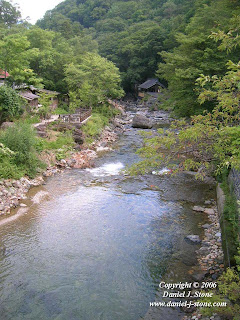My wife, who hails from Tokyo, was teaching me about how I need to learn to let go of the things that have happened to me in my past and do as the Toyota commercial in the US states, "Moving Forward". As usual, she is correct, and reemphasizes the importance of "Listen to what people tell you."
In Japan, there is a phrase which refers to "a woman who brings good fortune for her boyfriend"(ageman). This is purely a Japanese word which has nothing to do with "age" or "man". It is pronounced correctly by using the Japanese consonant-vowel combination "A-ge-ma-n".
The opposite of ageman is sageman which is a person who has the undesirable characteristic of absorbing others' good luck. So, ageman comes from the Japanese verb "ageru" meaning to raise and sageman comes from the Japanese verb" sageru" meaning to lower. Therefore, it all comes down to the question, "Do you bring out the best in someone or do you bring the people around you down?"
There is a Japanese movie from the 1990s and if you are fortunate, you can find it with English subtitles. The name of the movie is Tales of a Golden Geisha produced by my favorite Japanese director, Itami Juzo. I have not seen this movie by Juzo but imagine that by watching this movie, you can get a better idea of Japanese culture in terms of ageman.
In closing, I'm truly blessed to have ageman courtesy of my wife.
The Divine Wind Vault
http://divinewindvault.blogspot.com
(C)2006-09
The Kamikaze (Japanese term for divine winds) have protected Japan and its unique culture from foreign invasions and imperialization since the beginning of time. The roots of this blog were of an idle mind which took place my final year in Japan, 2006-2007. I still continue this blog eventhough its roots came from my day-to-day experiences in Japan.
Google AdSense
Friday, May 29, 2009
Thursday, May 28, 2009
Modern-Day Samurai

After the time of the samurai (roughly the mid 1850s), Japan went through many changes. However, the Way of the Warrior (Bushido) values could still be seen. During W.W.II, Japanese suicide pilots, known as kamikaze (divine winds), looked to the samurai and Bushido for their inspiration. During the 11th century when the Mongols were trying to invade Japan, a series of storms stopped their invasion. These were thought to be divine winds which were sent by the gods to save Japan.
Only one time in Japan's history have they been occupied from the outside with the defeat in World War II in 1945. On January 5th, 1945; Japanese government approved the use of warplanes to be flown into US-led Allied Forces' ships. These missions were known as Kamikaze Raids. Maimed Japanese warplanes would maneuver themselves so that they would crash not into the ocean but into the side of a US warship. These raids managed to damage 30 ships and killing 5000. Months later, the war was ended with the atomic bombings of Japanese cities Hiroshima and Nagasaki by the United States on August 6th and 9th, 1945.
The Japanese again believed that these pilots were sent to save Japan. Kamikaze pilots had no fear of death. Their loyalty to their country made them willing to die.
After W.W.II, the Japanese army was disbanded. A new type of warrior evolved: those who wanted modernization and industrialization. Huge companies called financial business conglomerates (zaibatsu) formed. They were more like families rather than companies. Loyalty for one's company and company name was great. Even today within these company workers have great respect for their bosses and for the heads of the companies. To be unjust or commit a misdeed would bring shame to their company and themselves. Today Japanese have a term, "Business is War." Bushido values can still be seen today in Japan.
The bushido-minded Japanese have the utmost respect and loyalty to their country, and they would not do anything to bring shame upon their family. Today the two most popular religions in Japan are Buddhism and Shintoism. Both were great influences on Bushido. Zen Buddhism which was also an origin of Bushido, is a doctrine followed by many today.
Today's image is of the Japanese flag with the sunburst which was the common flag during World War II.
The Divine Wind Vaulthttp://divinewindvault.blogspot.com
(C)2006-09
Monday, May 25, 2009
Baptism by Fire-Tackling the Language Barrier while you are in Japan
Tackling the Language Barrier while you are in Japan
One of the biggest obstacles between getting something done or not in Japan is the very aspect most of us take for granted...differences in language.
When my Japanese wife was a university student in Los Angeles, she would do many things to emerge herself into English language and American culture. For example, she would watch TV with her home stay family with the English subtitles on (the kind used in the US for the hard of hearing). She would do other things like hang out with one of the instructors at her language school with the other students. Also, she enrolled in classes at the nearby junior college. After I met her, I told her that it was OK to not attend school everyday during the week as long as the units were met to keep her as a full-time student. The Japanese can be very diligent in that regard.
But, like most foreigners who spend enough time in a country that is not their own, they miss out on things. My wife never ate at a Subway Sandwich shop until we started dating since she did not want to deal with, "What would you like on your sandwich?" "White or wheat bread?" "Swiss or cheddar cheese?" In the early days, I lived in San Diego and she was in the South Bay part of Los Angeles. Those early days were trying times since we lived 100 miles apart from each other and traffic in Southern California just plain sucks. But to top things off, my wife was a new driver at 25 years old since driving is discouraged (two-lane roads the size of a driveway and mirrors at every corner since they all contain "blind-spots", gas 4 times as much as it is in the US, etc.) if you are from Tokyo. She had been driving for about 2 years and had managed to use the freeways in LA a few times. She managed to gain the courage and in those early days, we saw each other twice a month for a few days each time with me driving to LA and her driving to SD.
My first time to Japan was completely different that my most recent stay in Japan. My first time around, I only went to Kamakura, Yokohama, Tokyo and Hakone. This was due to the fact that I had limited funds and time in Japan due to my military obligations but mainly due to my inability to breakaway from the pack and with determination venture out beyond my comfort zone. Furthermore, in those days, I did not have a laptop; Internet was yet to be released and did not have a cell phone or a land line for that matter.
The point being is, you have to strike while the iron is hot. If you are not confident of your Japanese ability, and worried about getting lost, there is only one way to cure the problem. Baptism by Fire. Through the international use of hand language, and sheer determination on both parties, use of the technology at our disposal and good, old-fashioned maps and dictionaries, you can make things happen when it comes to getting the most out of your stay in a foreign country.
Tip- If you are in Japan and need to ask for directions, ask a younger person if given the choice. Older people, especially train station employees, have been useless more times than not. Once at the mother of all train stations, Shinjuku, in Central Tokyo, I asked an old employee for directions to a train line IN JAPANESE. The guy began rattling off his reply in Japanese so fast that I was lost after the 3rd word. I then asked him to say it again in Japanese but this time more slowly, and he basically blew me off. I then found a younger female who was more helpful and took the time to help. Of course she didn't speak any English.
I hope this helps and remember, don't let the opportunity pass you by.
Today's picture was taken when I was an ESL teacher in Japan. I'm giving a farewell speech in Japanese to the student body in their gym.
The Divine Wind Vault
http://divinewindvault.blogspot.com
(C)2006-09
First places to see in Japan

Today's picture was taken from Roppongi of Tokyo Tower.
Since most international flights arrive at Tokyo's Narita Airport, I will discuss Tokyo in general. In no particular order, I would suggest Tokyo Tower. Conveniently located in Central Tokyo near the gaijin-friendly district of Roppongi (entertainment district) and Ebisu (embassies). If you want a taste of Japan's culture, go to Asakasa. There are many temples and people carrying out activities as they were done back in the days of the samurai (Edo Era). For bright lights and city life, it is recommended to visit Tokyo's Shinjuku Ward. Just outside of the main station is a place that I would like to stand and just take pictures.
Harajaku is an interesting place because it has the Meiji Shrine as well being the hang out for Tokyo's trendy teenagers. Not too far from Harajuku Station is a great sushi chain called Kappa Sushi. It is user friendly for foreigners. Just sit a booth and the sushi comes by on a conveyor belt. Take what you like and everything is 100 yen (roughly US$1).
The futuristic district of Odaiba is a good place that requires riding the sky rail from Shimbashi Station. The view from the sky rail is awesome. On the way back you can travel by boat.
Just south of Tokyo is Yokohama (Japan's Chinatown). Chinese food in Japan is quite different that Chinese food found in the US. Prior to moving to Japan, I did not care for Chinese food but after several visits to Yokohama's Chinatown, I yearn for the day I can return to Japan.
A bit further south of Yokohama is the ancient capital city, Kamakura, the home of the "Great Buddha". North of Tokyo in Saitama City and the home of the John Lennon Museum.
Sumo, baseball and soccer matches nearly all the time depending on the season. Even a few preseason NFL games. Also, concerts ranging from favorites from back home and J-pop artist.
All of the above information was put to use when a friend of my family traveled to Japan to visit me and only had the better part of an afternoon to spend with me. We had a chance to meet in front of Ueno Station`s Hard Rock Cafe.
From here we went to Asakusa to view the temples and shop for trinkets. Today's picture was taken here. After that, we went to Akihabara to look at some electronics and ate dinner at Sushizanmai Sushi Rest. I recently had the chance to catch the Discovery Channel's Lonely Planet episode that featured Tokyo. One of the places featured in this segment was Akihabara and it discussed the fanatics/maniacs of anime (okaku) and the pretty girls in outrageous costumes, mainly maid outfits that play board games for a price with Japanese men usually 20 years older than the girls. This phenomenon is known as costume play (cosplay) and in Japan there is an entire segment of this which borders on perversion, at least in my mind. Since I usually go out in Tokyo with my wife or mother-in-law, it was a new challenge for me to take the lead and as predicted I got turned around each time we left or went to a different place. In Akihabara, I found myself asking a young woman in a maid outfit for directions to a rotation sushi bar (kaiten). Of course, my guest wanted to know the reason for her outfit. Considering how he is a person of the cloth, I dodged it slightly and said that she works at a coffee shop and this is her costume. Another feature in the Lonely Planet episode was the sushi restaurants that bring the sushi to you on a conveyor belt and I was happy to have the chance to take my visitor to this uniquely Japanese phenomenon. This place has the sushi rotating around on a conveyor belt and is probably the best sushi chain around. Afterwards, we went to Shinjuku to look at the Tokyo skyline from the Metropolitan Building.(Tocho) Afterwards, we parted ways at Shinjuku Station and I returned to Warabi, Saitama at 11PM and followed the mass-exodus of drunken salarymen from the station back to the apartment complex (danchi).
Recap- First Places to See in Japan (Tokyo)
- Roppongi (entertainment district)
- Ebisu (embassies and Western grocery outlets)
- Asakasa (many temples and people carrying out activities as they were done back in the days of the samurai)
- Shinjuku (Tokyo's bright lights and city life)
- Harajaku (Meiji Shrine and trendy teenagers)
- Odaiba (Shimbashi Station)
- Yokohama (Japan's Chinatown)
- Kamakura (Japan's ancient capital city)
- Saitama City (John Lennon Museum)
Recap- The Tokyo Whirlwind Day Tripper
- Ueno Station`s Hard Rock Cafe
- Asakusa
- Akihabara
- Shinjuku Tokyo's skyline from the top of the Tokyo Metropolitan Building
The Divine Wind Vault
http://divinewindvault.blogspot.com
(C)2006-09
Japanese Onsens

Today's picture was taken at Takaragawa, Gunma the home of one of the largest outdoor co-ed baths in Japan. If you squint your eyes hard enough you may see some people bathing in the background.
When we lived in Saitama, we rented a van and drove to Gunma one summer day. The sights were awesome, the food was unusual but the highlight of the trip was the onsen (hot spring) in the town of Takaragawa. Here is the home of one of the largest outdoor co-ed baths (konyoku) in Japan.
This onsen was an outdoors facility and as we were walking to the changing room, I noticed women wrapped in yellow towels in the same bathing area with men. Before entering the bathing area I noticed how the men were covering up their privates only with a white hand towel. I followed their lead and bathed for about 15 minutes in the first bathing area. The water was too hot for me. I walked across a bridge with both hands on my waist so the towel would cover my privates. My backside was fully exposed for the whole world to see. The second bathing area was much more tolerable and more of the same. More women wrapped in towels and men holding a hand towel over their privates. Children were also in the bathing area with their parents. Some women did not wrap up in towels but only covered up the front parts. Some men decided to let it all hang out. One notable thing was that the towels on the women become transparent after they stood from soaking. I noticed this from the first bathing area after I held the towel too closely to my body.
Apparently, the eyes of the Japanese do not go to the areas of the opposite sex's bodies that are considered forbidden. Since I'm not Japanese, I can say that there was no shortage of privates on display. I managed to find a corner and was semi-floating in 3 foot deep water with my hands holding my towel over my privates and with my eyes cracked open, mainly a quint from the sun, I watched a parade of Japanese women of various ages strutting by with their boyfriends, husbands and children. Believe it or not, I learned the proper way to exit the water preventing the towel to become see-thru as observed when several women left and since they were holding their towels too close to their wet bodies. If it was held loose against them, nothing was visible.
Prior to this outing, we'd been to various hot thermal springs (onsens) as well as public baths (sentou) in the Tokyo and Kanagawa area. There has always been an issue of me and onsens in Japan. This is because I have a tatoo and I'm a foreigner. These days, the local onsen operators tend to have relaxed their stance on allowing foreigners to bathe since in most cases they will have a Japanese host with them showing them the way. Some of the most colorful tatoos that I've ever seen were on the backs of Japanese men at onsens symbolizing them as members of the Japanese mafia, (yakuza). While this may be the case, bear in mind that your one of a kind experience of onsens in Japan may have some bumps in the road.
Onsens are tourist attractions in Japan and any Japanese town that has a large number of these will have a fat bottom-line due to the Japanese flocking to them when time permits to rest and relax. Most are segregated with men and women bathing separately but a few still exist allowing both to bathe together. The first time I tried mixed gender bathing (konyoku) was when I first arrived in Japan. I was participating on a tour and was the only foreigner. My Japanese wife observed several signs stating that tattoos were prohibited. My wife asked about this and was told that the establishment did not mind but some of the patrons might. He suggested that we bathe together in private which was a excellent alternative.
The Divine Wind Vault
http://divinewindvault.blogspot.com/
(C)2006-09
Subscribe to:
Posts (Atom)

